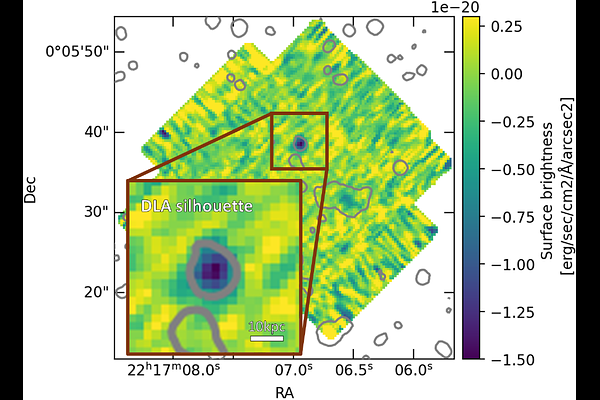The first direct imaging of the silhouette of a damped Lyman $α$ system along the line-of-sight to a background galaxy

The first direct imaging of the silhouette of a damped Lyman $α$ system along the line-of-sight to a background galaxy
Fuga Komori, Akio K. Inoue, Ken Mawatari, Yuma Sugahara, Hideki Umehata, Rhythm Shimakawa, Satoshi Yamanaka, Takuya Hashimoto, Jorryt Matthee, Toru Misawa
AbstractThe H~{\sc i} gas distribution in damped Lyman $\alpha$ absorbers (DLAs) has remained elusive due to the point-source nature of background quasar emission. Observing DLAs against spatially extended background galaxies provides a new method for constraining their size and structure. Using the Keck Cosmic Web Imager, we present the first ``silhouette'' image of a DLA at $z=3.34$, identified in the spectrum of a background galaxy at $z=3.61$. Although the silhouette remains unresolved due to limited spatial resolution, this represents a successful proof-of-concept for studying DLA morphology using extended background sources. Possible residual emission in the DLA trough suggests an optical depth contrast exceeding $10^7$ in the internal structure, implying a sharp edge or patchy structure. A Lyman $\alpha$ emitter (LAE) at $z_{\rm LAE}=3.3433\pm0.0005$, consistent with the DLA redshift, is detected at an angular separation of $1.''73\pm0.''28$ ($12.9\pm2.1$ kpc). The DLA is surrounded by three galaxies within 140 kpc in projected distance and 500 km s$^{-1}$ in line-of-sight velocity, indicating that it resides in the circumgalactic medium of the LAE or within a galaxy group/protocluster environment. An O~{\sc i} $\lambda1302$ absorption at $z_{\rm OI}=3.3288\pm0.0004$ is also detected along the line of sight. This absorber may trace metal-enriched outflow from the LAE or a gas-rich galaxy exhibiting the highest star formation activity among the surrounding galaxies. Future large spectroscopic surveys of galaxies will expand such a DLA sample, and three-dimensional spectroscopy for it will shed new light on the role of intergalactic dense gas in galaxy formation and evolution.